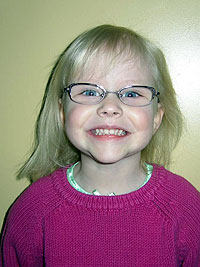 Ellie didn't know she should be seeing any different. Imagine spending your entire life seeing clearly through only one eye. That is what it is like for kids with amblyopia. Until they are diagnosed, these children go through life thinking everyone sees the way they do: blurry in one eye and clear in the other. They have no idea they should be seeing any other way. Such was the case for three-year-old Ellie, who was diagnosed with amblyopia last December. Screened by the Sight & Hearing Association (SHA) at Hosanna Preschool in Lakeville, Ellie's vision was 20/30 in her right eye, but 20/100 in her left. Her brain was essentially learning to turn off vision to her left eye.
Ellie didn't know she should be seeing any different. Imagine spending your entire life seeing clearly through only one eye. That is what it is like for kids with amblyopia. Until they are diagnosed, these children go through life thinking everyone sees the way they do: blurry in one eye and clear in the other. They have no idea they should be seeing any other way. Such was the case for three-year-old Ellie, who was diagnosed with amblyopia last December. Screened by the Sight & Hearing Association (SHA) at Hosanna Preschool in Lakeville, Ellie's vision was 20/30 in her right eye, but 20/100 in her left. Her brain was essentially learning to turn off vision to her left eye.
Amblyopia is the medical term used when the vision in one of the eyes is reduced because the eye and the brain are not working together properly. The eye itself looks normal, but it is not being used normally because the brain is favoring the other eye. This condition is commonly called lazy eye.
Ellie's mom is grateful for the screening that found her daughter's eye condition. “I noticed that she would bring books close to her, or would stand close to the TV," explained her mom, "but I thought that was just her. All kids seem to do that. I didn't think it was unusual. Without this screening, my daughter would still be seeing that way."
Amblyopia is the most common cause of visual impairment in childhood. The condition affects approximately 2 to 3 out of every 100 children. Unless it is successfully treated in early childhood, amblyopia usually persists into adulthood, and is the most common cause of monocular (one eye) visual impairment among children and young and middle-aged adults.
For Ellie, treatment means wearing glasses full time and an eye patch up to four hours a day. The patch is placed over her strong eye, which forces the weaker eye to work. She wears the patch to preschool, where she does a lot of close-up activities, such as looking at books, doing crafts, coloring and playing with Play-Doh. After getting her new glasses, Ellie was quick to point out the things she could see. "She said, 'Oh wow, I can see those colors on that sign,'" recalls her mom. "She definitely notices when she doesn't have her glasses on." Because of Ellie's condition, which often is hereditary, her two-year-old sister, Georgia, also has been tested. She does not show signs of amblyopia.
Ellie’s mom is thrilled her daughter is getting the help she needs thanks to SHA. "I'd rather be going through this now, when she's young, then later, when it could really have affected her life."